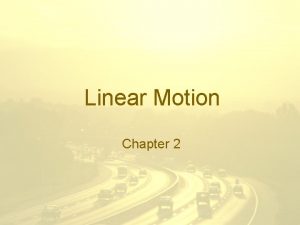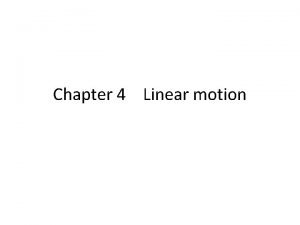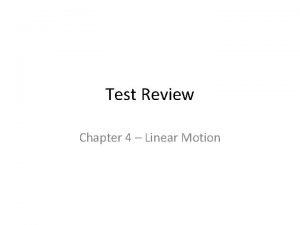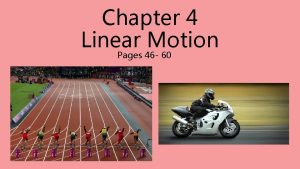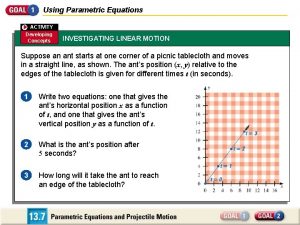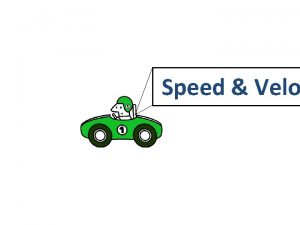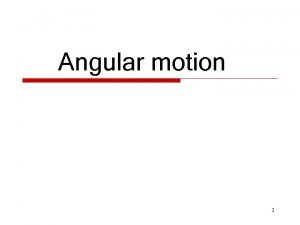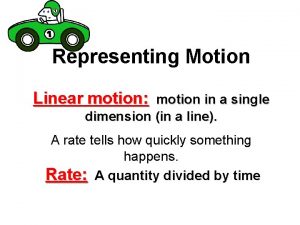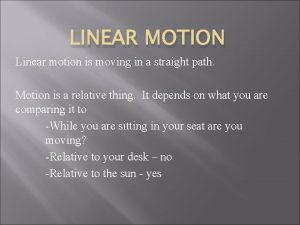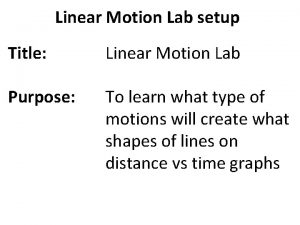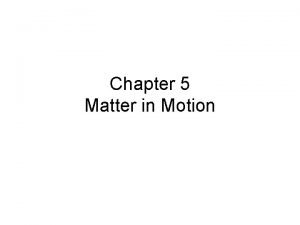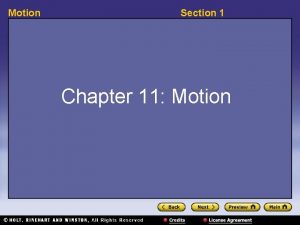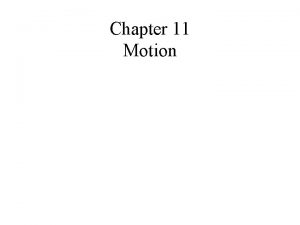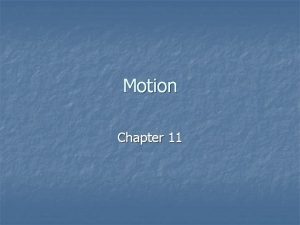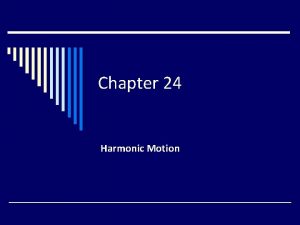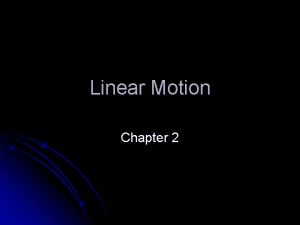Chapter 2 Linear Motion What is linear motion














- Slides: 14

Chapter 2 Linear Motion

What is linear motion? u Motion- change in position over time u linear motion- motion in a straight line u or motion in 1 dimension (1 -D)

u Is How do you determine if something is moving? a person sitting still in a car going 35 m/s moving? u Are you moving now? u Earth orbits at 30 km/sec, and revolves at 266 mph u What about a character on a video game that is apparently running across the TV? u In order to determine if something is moving you have to compare it to something that is considered to be not moving or stationary.

Frame of reference u Whatever you compare it to is called your frame of reference. u The most common frame of reference is the Earth. u *there is no such thing as a perfect frame of reference, everything is moving.

Motion is always relative to something. u Using the person in a car going 30 m/s. Describe the motion from each frame of reference. – The Earth the person is moving fast (30 m/s) – The car’s interior the person is not moving – To another car going 31 m/s the person is slowly moving backwards (1 m/s)

Vector vs. Scalar Units Scalar unit- is any unit that doesn’t have a direction- (total distance you walked to this class, walking up stairs, speed on speedometer, directions from mapquest) u Vector Unit- Any unit that has a constant direction associated with it (how high is the 2 nd floor, straight line on a map) u Scalars Vectors Units u Distance Displacement meters (m) u Speed Velocity m/s u

We will use all metric units u It is significantly easier if we do. u A meter is a little more than a yard. u For speed, m/s is just under half of miles per hour. u 68 mph = 30 m/s

What is speed? Speed- how fast something is moving u or how much distance is covered in a certain amount of time u There are two types of speed we will discuss. u Instantaneous speedu An object’s speed at any given instant. u Average speedu An average of all instantaneous speeds u

To calculate average speed u average us speed = total distance/time = d/t u If you cover 75 m in 3 sec, how fast are you going? u 25 m/s u If you travel 20 m/s for 4 m, how long did it take you? u. 2 s

Velocity u Velocity is the same as speed, but it has a direction associated. u Can something have a constant speed but a changing velocity? u Yes, all it has to do is turn.

Negative velocity and speed u Is it possible for something to have a negative velocity? u Yes, it means it is going backwards. u -5 m/s N is the same as 5 m/s S. u Is it possible for something to have a negative speed? u No, there is no specific direction u Backwards depends on your frame of reference

Combining vectors in 1 -D u simply add them together. u If you walk 5 m N, 2 m S and 3 m N, what distance have you walked and what is your displacement. u distance- 10 m u displacement- 6 m N u If you are walking towards the back at 1 m/s in a bus that is moving 10 m/s… u you are moving 9 m/s (forward) u *note* you cannot combine speeds

Acceleration u Acceleration- change in velocity over time. u to calculate acceleration: a= vf – vi (f and i mean final t and initial) The units of acceleration are m/s/s or m/s 2

Negative Acceleration u What does a negative acceleration mean? u The object is slowing down. This is also sometimes called deceleration. u It does NOT necessarily mean the object is going backwards (yet)
 Chapter 2 motion section 1 describing motion answer key
Chapter 2 motion section 1 describing motion answer key The main difference between speed and velocity involves
The main difference between speed and velocity involves Chapter 2 section 1 describing motion answer key
Chapter 2 section 1 describing motion answer key Conceptual physics chapter 3 linear motion
Conceptual physics chapter 3 linear motion Chapter 2 linear motion
Chapter 2 linear motion Chapter 4 linear motion
Chapter 4 linear motion Chapter 4 test linear motion answer key
Chapter 4 test linear motion answer key Chapter 4 linear motion
Chapter 4 linear motion Chapter 2 assessment physics
Chapter 2 assessment physics Passive rom vs active rom
Passive rom vs active rom Harmonic equation physics
Harmonic equation physics An object in motion stays in motion
An object in motion stays in motion Describing motion lesson 1 answer key
Describing motion lesson 1 answer key Section 1 describing motion
Section 1 describing motion In a pumpkin tossing contest in morton illinois
In a pumpkin tossing contest in morton illinois




